| 1 | A southern Californian rattler |
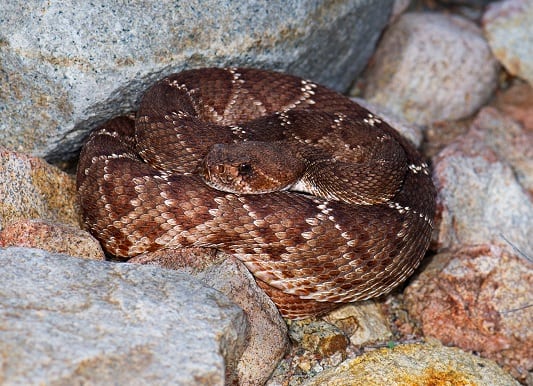
If you’re staggering around the remote California countryside for some reason, maybe after your car broke down close to sunset, and you fall down and look up, only to see a rattlesnake gazing at you, you should pray that it’s one species: the red diamond rattlesnake (Crotlaus ruber).
This rattlesnake species inhabits only one US state, California, but is extremely abundant in the southern half. Unlike the Pacific rattlesnake, red diamond rattlesnakes avoid towns and cities, preferring to dwell in rocky desert foothills, covered with a layer of wispy grass and shrub. They’re commonly encountered by hikers and dog walkers in the California hills, but the good news is that of the 15-20 US rattlesnake species, this is one of the calmest.
Red diamond-ers are relatively timid, and prefer to stay quiet rather than attack, hoping that people will keep on stomping past. Red diamond rattlesnakes rarely use their rattles, and will even hide their head occasionally, stashing it in their coils to protect their brain. If they do turn aggressive, then they bring the full rattlesnake spectacle: hissing, loud rattling, mock lunges, and finally a real lunge and bite. However, this happens much less often than say, a west diamondback.
Red diamond rattlesnakes average at 100-140cm, with a record length of 162.5cm. This falls well short of the west diamondback, with its 233.7cm record, but easily outstrips a tiger rattlesnake (91.2cm).
| 2 | Habitat: dry, open spaces |
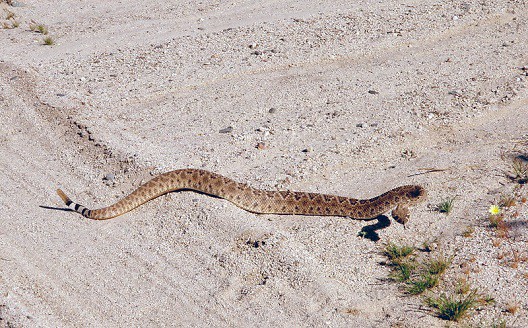
Red diamond rattlesnakes are a species of open dry spaces. They rarely appear in forests, and have a close connection to rocks. They love sparsely vegetated foothills, with an abundance of granite boulder outcrops and loose rocks, which they exploit for thermoregulation. They’re also found in semi-deserts with a mixture of rock and cacti, particularly near prickly pear cacti. Red diamond rattlesnakes often hibernate beneath cacti, although this comes at a cost. This species is sometimes spotted with spines embedded all around their mouths and tails.
Grasslands are another possibility, particularly those with plenty of rocks. Red diamond rattlesnakes are a medium to low altitude species, reaching 1500 metres, avoiding high mountaintops, but loving the scenic slopes below. While Crotalus ruber sometimes appears in spacious woodland, they have no need for trees whatsoever (unlike a timber rattlesnake, which literally requires timber).
Further west, along California’s busy coast, this is mainly a creature of coastal sage scrubs, particularly scrubland with plenty of rocks. This isn’t a species of true deserts, and you won’t find them alongside sand-surfers like the sidewinder.
| 3 | A relatively mild venom |
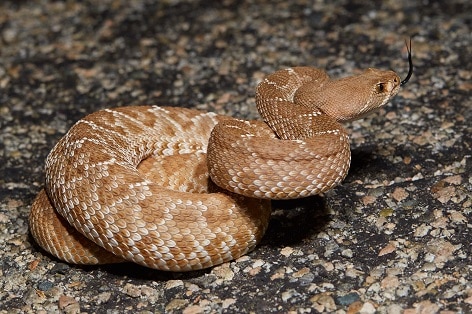
Red diamond rattlesnakes have a typical viper venom, which specialises in swelling and blood chaos rather than paralysis. The venom has at least 3 different haemorrhaging proteins, which cause spontaneous bleeding. These also cause muscle damage, as evidenced by a rise in the biomarker creatine kinase.
The most eye-catching study so far compared Crotalus ruber to three other rattlesnakes. The speckled rattlesnake (Crotalus mitchelli) was overwhelmingly the deadliest, with a neurotoxic venom achieving an LD50 lethality score of 0.45mg. The Baja California rattlesnake ranked second at 1.56mg, followed by the Santa Catalina rattler at 2.98mg. Red diamond rattlesnakes ranked dead last, at 9.21mg. Crotalus ruber also possesses virtually no neurotoxins, such as the Mojave toxin found in tiger rattlesnakes.
But here’s where things get more complicated: red diamond rattlesnakes have a very high venom yield, corresponding with their large size. The average injection per bite is 364mg, compared to 31mg for a Baja California rattlesnake. Venoms can vary, and scientists in Mexico once found 3 individual red diamond rattlers that did possess mojave toxin.
| 4 | Variable venom by region |
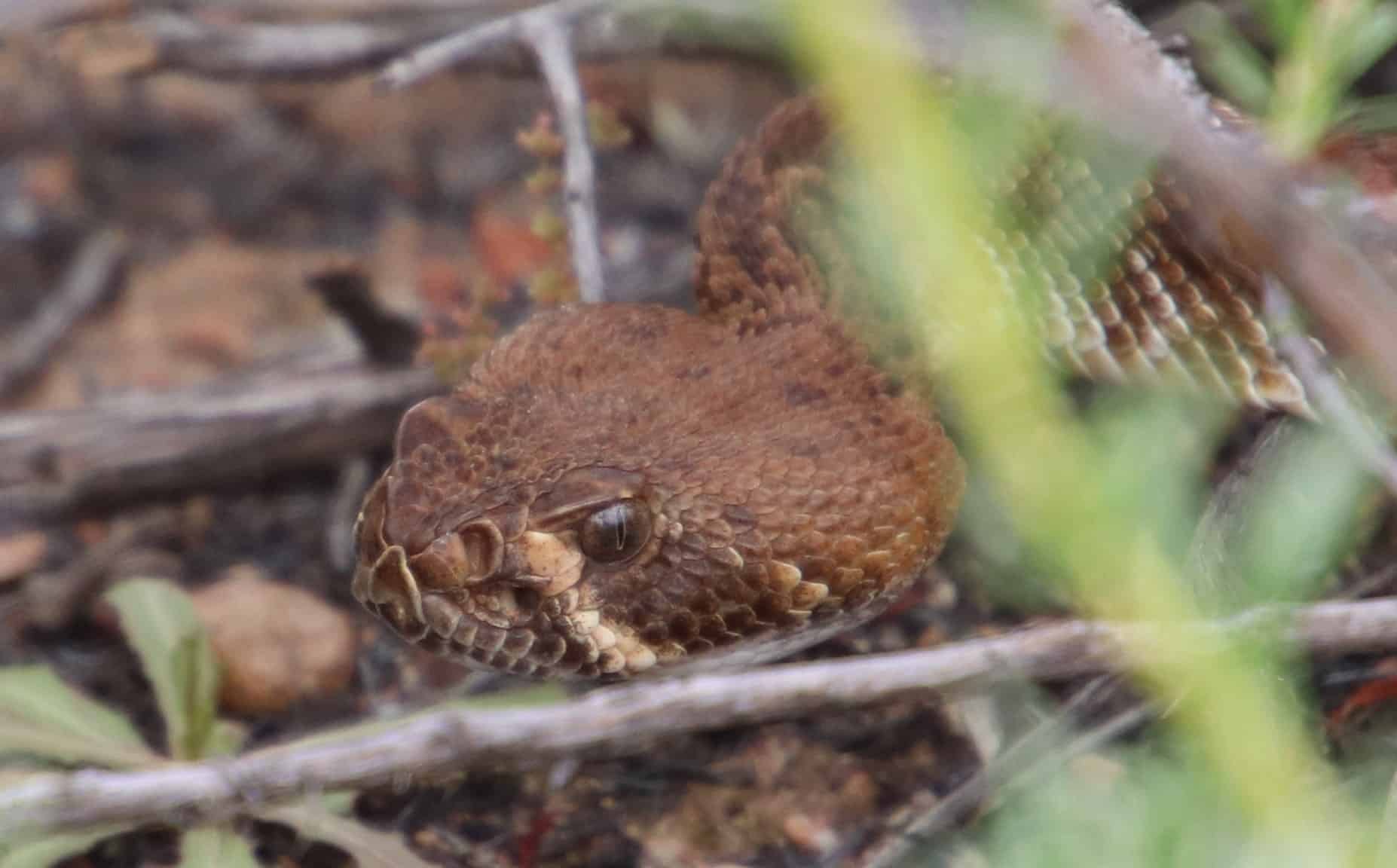
In theory, this is one of the milder rattlesnake venoms. But watch your step, for Crotalus ruber venom is proven to vary by region. One of the three subspecies is the San Lucan diamond rattlesnake (Crutalos ruber lucasensis), found only in the southern regions of Baja California, Mexico. A 2020 study tested snakes from three locations: the arid Magdalena Plains, the semi-arid Central Gulf Coast and tropical Cape Deciduous Forest.
Crotalus ruber venoms from the Central Gulf Coast were 3.1-4.9 times deadlier than the other two locations. CGF venom was also most powerful against blood clotting, producing fully unclottable blood in mice, while the other two only managed partly unclottable. Likewise, CGF was the only red diamond venom to have noticeable defibrinating activity in a mouse test – the destruction of fibrinogen, the backbone of blood clotting. In human plasma, CGF was again the only location able to affect blood clotting.
Despite this, haemorrhaging powers were stable across the three locations, possibly because they attacked the blood vessel linings as well, priming them to burst. Meanwhile, Cape Deciduous Forest rattlesnakes had the strongest venom for swelling (edema), a less fatal speciality.
| 5 | ID signs: check the tail |
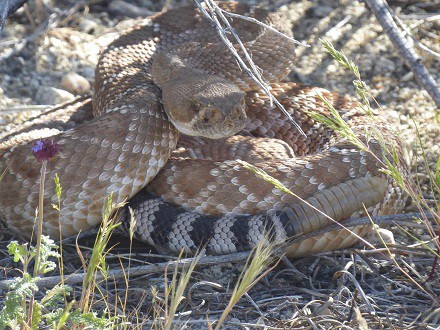
The red diamond rattler may be the simplest rattlesnake to recognise of all. Some species are an indistinguishable blending of beige and brown, but Crotalus ruber is reddish-yellow in distinctive diamond blotches. Red diamond rattlesnakes have virtually no sexual dimorphism; males and females have the same colours and patterns.
The most recognisable section is the tail. The 8-10 segmented rattle scales are beige, and this is preceded on the actual tail by rapidly alternating black and white bands. These contrast vividly with the rest of the body. Take this picture. It shows a pleased-looking cotoye carrying away its meal, which it seems to have caught on an open road, where the snake has foolishly basked. From a distance, many of the snake’s features are incomprehensible, but the black and white tail gives it away clearly as a red diamond rattlesnake.
Other features include a fully grey tongue, and an average newborn clutch of 3-20, usually born in September.
| 6 | Diet: over 90% mammals |
One study collected 272 preserved red diamond rattlesnakes from museum collections, and found identified 227 preserved prey items. It transpired that red diamond rattlesnakes were overwhelmingly a mammal-eater, one of the most heavily of the rattlesnake family. Their diet consisted of 208 mammals (91.6%), 17 lizards (7.5%), and two birds (0.9%). The study identified 20 separate mammal species, and the most abundant meal of all was the dusky footed woodrat, recorded 16 times. This backs up constant sightings of red diamond rattlesnakes slithering into woodrat dens.
The second most popular prey was the desert cottontail rabbit (11 sightings), while the most popular reptile was the western whiptail (6 sightings). One of their largest meals was a western spotted skunk, and there were plenty of deer mice, kangaroo rats, and pocket mice. Crotalus ruber was equally as reliant on mammals in adulthood and as a juvenile.
No snake meals were recorded. Red diamond rattlesnakes do have at least two confirmed snake predators: coachwhips and California kingsnakes.
| 7 | Rarely travels long distances |

Red diamonds are easily one of the laziest rattlesnakes. According to a 2008 study, males move an average of 6.8 metres per day, and females 3.6 metres. The female home range size was estimated at 0.9 hectares, which was similar to twin-spotted rattlesnakes at 0.8 hectares, yet red diamond rattlesnakes are twice as large as that species. Males move further than females – while they make movements the same amount, they tend to move further at once than females.
The likes of prairie rattlesnakes can travel 10 miles to feeding grounds, but in this study, the red diamond rattlesnakes usually stuck within 300 metres of their hibernation site. They rarely re-entered their dens during the year, but often slithered past the dark entrance. Crotalus ruber virtually never climbs vegetation, but they often bask on rocks proudly, with a stunning Californian view in the background.
Crotalus ruber is another rattlesnake whose venom changes with age. As an adult, the proteolytic activity is 6-15 times greater than as a juvenile. These are toxins which physically assault cell structures and cause necrosis and massive swelling.
| 8 | Hibernates in boulder cracks |
In one tale from 1932, 24 red diamond rattlesnakes were blown out of the same rock crevice in San Diego County, California. While Crotalus ruber sometimes hibernates singly, they also gather communally, resting with each other peacefully. It’s common for a handful to gather in one hibernaculum, their favourite spots being cracks inbetween a large granite boulder outcrop.
They’re also attracted to burrows of pack rats (Neotoma family). Red diamond rattlesnakes can be loyal to hibernation spots, sticking to the same rock crevice every year, while a few are dissatisfied and constantly changing.
This species nearly always enters hibernation in November. On average, red diamond rattlesnakes leave their dens in late February, while a few lazier individuals wait until April. However, one sudden heatwave in January 2003 caused the local red diamond rattlesnakes to emerge early, and bathe in the sun en mass. When cool weather swept back in early February, they became inactive, but didn’t return to their dens.
| 9 | Mothers abandon their young |
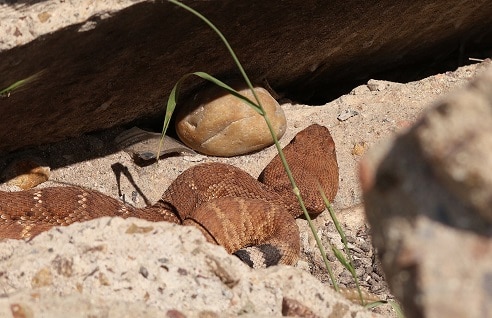
The red diamond rattlesnake’s closest relative is the Santa Catalina rattlesnake (Crotalus catalinensis), found solely on one Baja California island. This is essentially an island colony that became trapped by rising sea levels, leaving them free to spiral in a new evolutionary direction. Their next closest relative is the western diamondback (Crotalus atrox), and the two are estimated to have diverged 1.82 million years ago.
Meanwhile, mothers are some of the least caring of the family. Other species in California have all been seen caring for their offspring, usually for 10-15 days, including southern Pacific rattlesnakes, sidewinders, and southwestern speckled. Not red diamonds. While they may care occasionally, no observations have ever been made, and it’s presumed that mothers abandon their young immediately after birth.
That said, Crotalus ruber doesn’t completely shun company. In January 1997, a red diamond rattlesnake was spotted sharing a burrow with a desert tortoise, coexisting peacefully with its distant reptilian cousin, united in purpose by their cold-blooded bodies and need for shelter. The burrow was located was 50 metres from a wind turbine, in Palm Springs, Riverside County. Desert tortoises were plentiful in the area, and red diamondbacks had been spotted occupying their burrows before.
| 10 | Uses cacti to its advantage |
One study sought to explain how red diamond rattlesnakes could live alongside fellow members and not be outcompeted (or vice versa). A semi-arid area was analysed in Chino Hills State Park, California, where southern Pacific rattlesnakes also lived. This was a location without the usual rocks that Crotalus ruber gravitates towards.
There was a clear separation of habitat: the red diamond rattlers stuck to patches of prickly pear cacti, which the south Pacific rattlers avoided except during winter. Instead, the latter stuck to open grasslands and riparian habitat. This had a dire consequence; of the 9 southern Pacific rattlers tracked, 4 fell victim to predators, including coyotes, as they were visible in wide open spaces. Meanwhile, 0 of the 7 Crotalus ruber were hunted, and the prickly protection of cacti was thought to be why.
Red diamond rattlesnakes dislike urban areas, and their territory has been pushed back over the last 50 years, as California has added 5-10 million people. It’s estimated that compared to historic times, coastal sage scrub habitat has been reduced by 90%. In desert foothills, their populations are far stabler.
